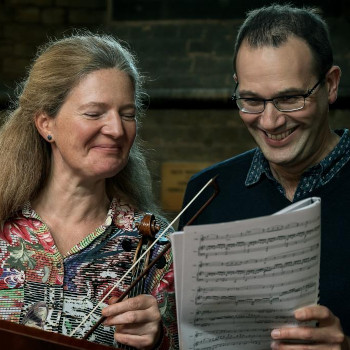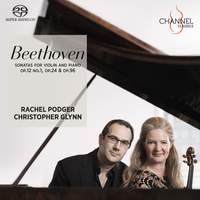Recording of the Week,
Beethoven violin sonatas from Rachel Podger and Christopher Glynn
Today’s Recording of the Week sees long-time collaborators Rachel Podger and Christopher Glynn (who teamed up to bring Timothy Jones's Mozart completions to life last year) reunite to offer three snapshots of Beethoven’s development and maturation as a composer, through the prism of his violin sonatas. A string player himself (playing the viola in addition to his well-known capabilities at the keyboard), Beethoven called on personal performing experience in crafting both parts of these works, and both Podger and Glynn draw out that sense of the music having being written by someone deeply familiar with the ins and outs of their instruments.
The sunny and extroverted Op. 12 No. 1 in D major, with its arresting, fanfare-like opening, shows the young composer still comfortably in a Classical mindset; the three sonatas in the Op. 12 set are dedicated to his teacher, none other than Antonio Salieri. Classical and even conventional they may still be, but in these sonatas Beethoven is already developing the form from its origins as a piano sonata with instrumental accompaniment into a more equal partnership. It’s fair to say that this is still a work in progress in the D major sonata; the piano part at times feels like it could stand alone without the violin. This presents the performers with a tricky balancing act, but at no point did I get any sense of either instrument being either overly prominent or inappropriately sidelined; their understanding of who should be in the limelight at any given moment is instinctive.
 At the halfway point of this journey is the “Spring” Sonata, Op. 24 – a nickname coined largely in response to the first movement’s sentimental opening. Podger imbues this lovely passage with a welcome sense of forward motion rather than succumbing to the temptation to linger. Glynn’s light-touch passagework doesn’t obscure the simple melodic line, though as the music develops he certainly explores depths of Romantic-leaning drama in his tone that would not have suited the earlier work. By this point the violin has become a much more equal partner than it was in the D major; Podger is constantly in a dialogue with the piano on a level playing-field, and indeed often seeming to lead the conversation.
At the halfway point of this journey is the “Spring” Sonata, Op. 24 – a nickname coined largely in response to the first movement’s sentimental opening. Podger imbues this lovely passage with a welcome sense of forward motion rather than succumbing to the temptation to linger. Glynn’s light-touch passagework doesn’t obscure the simple melodic line, though as the music develops he certainly explores depths of Romantic-leaning drama in his tone that would not have suited the earlier work. By this point the violin has become a much more equal partner than it was in the D major; Podger is constantly in a dialogue with the piano on a level playing-field, and indeed often seeming to lead the conversation.
A sense of similarity with the slow movement of the Pastoral Symphony (whose earliest sketches date from just a year after this sonata was published) grew on me as the Spring Sonata’s slow movement unhurriedly unfolded itself. In addition to its limpid mood and relative harmonic stasis recalling the Scene by the Brook, there’s a tentative repeated-note motif from both violin and piano that, for me, hints tantalisingly at the famous birdsong cadenza of the Pastoral. This parallel was only reinforced further in the brief Scherzo, which exhibits the same playful rhythmic “wrongness” as do the Pastoral’s peasant musicians. I wouldn’t want to say for sure that Beethoven was deliberately trying out ideas for the symphony in this sonata, but either way, Podger and Glynn enter fully into its vivid and at times similarly pictorial spirit.
The final sonata on the album – Op. 96, Beethoven’s last – is drawn from the rich vein of works inspired by the Archduke Rudolph’s patronage. The premiere was given by the Archduke himself (no mean pianist) and violinist Pierre Rode, whose own tastes influenced the shape of the work itself. Rode was reportedly no fan of bravura finales, and accordingly Beethoven instead crafted the final movement in the form of a theme and variations. Much though I enjoyed Podger and Glynn’s performances of the two earlier sonatas’ lively finales, this unconventional conclusion allows them to show a far greater breadth of expression. The sudden explosion of jollity in the final two minutes is all the more enjoyable in the light of this varied fare, and the last-minute pause for reflection gives the closing cadence the feeling of a well-delivered punchline.
We often hear about Beethoven the musical innovator, and rightly so, but it’s a rare privilege to be able to actually observe that innovation progressing. Podger and Glynn’s performances respond perfectly to the different ways he conceives the relationship between violin and piano, and allow us to hear the musical evolution of his sonatas unfolding before our ears.
Rachel Podger (violin), Christopher Glynn (fortepiano)
Available Formats: SACD, MP3, FLAC, Hi-Res FLAC, Hi-Res+ FLAC



